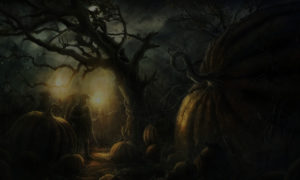-

By Dara Lyon Warner
(www.lyon-roars.com)
Gather ‘round, ye ghosts and ghouls,
To hear my tale of days long gone;
When Witches danced beneath the Moon,
And Druids waked the Sun at dawn.
They called the God and Goddess fair;
The Balefires burned high and bright.
The Ancestors they summoned in,
To join the Gathering through the night.
The veil grows thin; we stand in Circle,
Heart to heart and hand to hand,
Embracing still the Ancient ways.
Samhain has come again!
What is it about Halloween that brings out the giggling child in so many of us, despite our chronological ages? Perhaps it is tied to our memories of trick-or-treating when we still were those tykes, becoming pirates and monsters and fairy princesses. Whether we grew up here in North Carolina, or had to wear snowsuits under our costumes because there was six inches of snow on the ground by late October, we knew that sense of anticipation and magic — as though it was truly as tangible as its palpability made it seem.
The ancient Celts celebrated the first day of November as the start of the year. It marked the last harvest; the end of summer, and the beginning of winter. Not only did winter signify the death of plants and grasses, which could not survive the cold months, but it was often associated with human death, as well. The Celts believed that, on the eve of the new year, or Samhain — generally pronounced, “SOW-in” — the veil between the worlds was thin, allowing the ghosts of the dead to return to earth.
Enormous bonfires (“balefires”) were built; people within the community gathered, after extinguishing the fires on their hearths at home. Crops and animals were sacrificed to the fires, and fortunes were told. When the celebration was over, families re-lit their hearth fires using a burning brand from one of the sacred bonfires.
Within a few hundred years, Christian traditions began to supplant many of the ancient ways. By the Ninth Century, All Souls’ Day (or All Saints’ Day) was embraced. This observance was also called “All Hallows,” and the night before became All Hallows’ Eve, or Hallowe’en.
Another holiday celebrated contemporarily with Halloween is Día de Muertos. Ancestors and immediate family who have passed are honored with food, drink, music, and dancing. Central to this tradition is the ofrenda, an altar bearing images, mementos, and objects that belonged to loved ones, together with various foods, and perhaps toys or cigars, depending upon the ages of those who have gone before.
The Triangle Association of Freelancers (TAF) will meet on Wednesday, October 31, at Milton’s Pizza & Pasta, 8853 Six Forks Road in Raleigh. Dinner is at 5:30 p.m., and the meeting gets underway at 7:00 p.m., as usual. Milton’s has been our meeting venue for just a few months, and our welcome here has been remarkable. The staff makes a pizza and pasta buffet exclusively available to our membership; we also have access to their regular salad bar, at a reduced price. Alternately, anyone who wishes to do so may order from Milton’s regular, extensive menu.
In keeping with Halloween traditions, we will hold a costume contest, with restaurant staff as judges. We will award a prize for Best Costume, and one for Best Costume with a Literary Theme. Perhaps there will be a surprise or two, as well, but you will have to attend in order to find out!
For more about the history of Samhain, Halloween, Witches, and Día de Muertos, please see the following sources, which were drawn from for this article:
https://www.history.com/topics/halloween/history-of-halloween
https://www.history.com/topics/folklore/history-of-witches
https://insider.si.edu/2016/10/5-facts-dia-de-los-muertos-day-dead/
919-888-8198
3819 Donna Road
Raleigh, NC 27604
